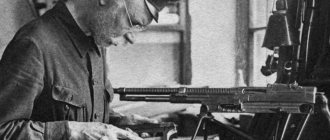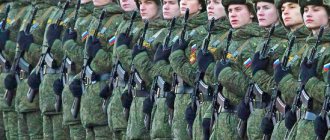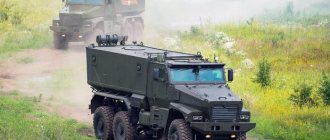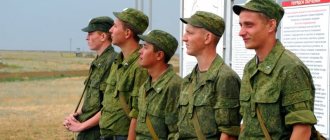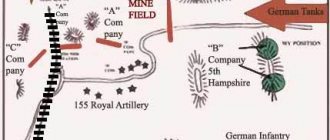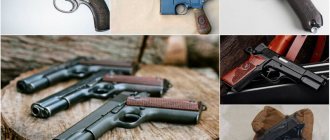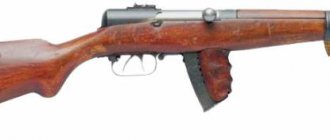Childhood and youth
Fedor Vasilyevich Tokarev was born on June 14, 1871 in the village of Mechetinskaya, Russian Empire. The inventor's father married the daughter of a wealthy Cossack, but was powerless and had no land plots. The boy grew up with his sisters Natalya and Ulyana, the rest of the children died.
Posted by Valery Kutushov on Tuesday, March 2, 2021
The inventor of the TT pistol Fedor Tokarev in his youth
Since childhood, the future Soviet designer had a passion for blacksmithing, plumbing and roofing; at the age of 7, he independently made a small plow out of wood and tin, made patterns for forged fences, made blue-painted windmills, and once carved a church out of brick, which pleased the devout grandmother.
Tokarev graduated from vocational, real and cadet schools, but was unable to enter a higher educational institution due to his low origin. In his youth, he was in charge of a weapons workshop, studied with masters Alexei Krasnov and Alexander Chernolikhov, served in the army as a cornet, a centurion, a captain, and was distinguished by his courage.
How the legend was born
At the end of the 1920s, the military command of the Red Army set gunsmiths the task of creating the first Soviet army self-loading pistol. It was supposed to replace the revolver and several models of foreign-made revolvers and pistols.
The competition was announced in 1929. The country's leading gunsmiths took part in it.
Article on the topic
Stechkin, a household name: the designer and his weapons Tokarev, working on his version, drew attention to the 1911 platform pistol, created by John Browning for the Colt factories. Noting its extremely successful bolt locking system and somewhat simplifying it, he applied not only this system, but also the entire layout diagram to the TT. The Browning scheme is still considered the most successful and is used in many modern pistols. By using Browning's design for the 7.62x25 cartridge (the American original had a much larger .45 ACP caliber), Tokarev managed to create an unusually powerful and compact pistol. Tests have revealed the superiority of the Tokarev pistol over many others in terms of weight, dimensions and shooting characteristics under various operating conditions.
In 1930, the TT pistol was adopted for service. Over the next years, the designer modernized it several times.
The Tula-Tokarev turned out to be an extremely successful model, which is called the best weapon of this type in the Second World War. Its production in the USSR continued until 1952, and in total about 1.7 million pieces were produced in our country alone.
Over the past decades, a huge number of different types of sports, traumatic and signal weapons have been produced on the basis of the TT.
Submachine gun of the Fedor Vasilyevich Tokarev system, model 1931, from the collections of the Central Museum of the Armed Forces of the USSR. Photo: RIA Novosti/V. Shiyanovsky
Gunsmith career
In 1902, Tokarev read an obituary dedicated to Sergei Ivanovich Mosin in the magazine “Weapons Collection”, and realized that he had to continue the work of the great designer. In 1907, he tested small arms in St. Petersburg and upgraded the Mosin rifle into an automatic rifle. The product was easy to assemble, lightweight, and resistant to dust, dirt, and falling from 3 meters. Since 1916, Fyodor Vasilyevich became a valuable specialist at the Tula Arms Plant; every year a new product of his authorship appeared.
Based on Stevens Maxim's easel gun, the genius developed a light submachine gun, which was adopted by the Red Army in 1925. Also on its basis, Tokarev created an aircraft model, which replaced the previously used Vickers. In 1927, the first Soviet machine gun chambered for revolver cartridges was created.
And in 1930, a self-loading TT pistol appeared, which pierced five 25 mm boards from a distance of 100 steps. During the Great Patriotic War, the model served the Soviet army well, as it was superior to the German Walther P38 in power and lethal force, and also had a simple design and low production cost. Initially, the TT was produced in Tula and Izhevsk, but more than 3 million units were produced worldwide in various modifications; their models appeared in China, Yugoslavia, Korea, Hungary, Poland, Czechoslovakia and even in Vietnam during the war with the Americans.
Designer Fedor Vasilievich Tokarev with SVT-40
Posted by Russian Ministry of Defense on Monday, April 13, 2015
Designer of the SVT-38 self-loading rifle Fedor Tokarev
The original prototype was immortalized in photographs of the winners of the Great Patriotic War; John Moses Browning himself admired it. The TT also became an exhibit in the Paris Army Museum, located in the historical building of the Palace of the Invalides of Louis XIV, where a memorial to Charles De Gaulle is located.
The SVT self-loading rifle, or “Svetka” as the Red Army soldiers called it, appeared in 1938. In its manufacture, a number of steels with unique characteristics were used, and even two that were specially designed for this weapon. Because of this, she turned out to be very capricious, sensitive to gunpowder, and especially “did not like” the American lend-lease. It produced a lot of soot, which clogged the gas channel, and its permeability was regulated by a special key, which was often lost.
The soldiers were afraid to pick up a rifle, and even the Germans, who captured samples with full ammunition, then did not fire a single shot. But in the USA the product was studied and served as the basis for the M-14, and in Russia for the OSK-88 self-loading hunting carbine.
War and revolution prevented the completion of the automatic rifle
At the age of 16, he entered the Novocherkassk military craft school, after which in 1891 he was sent to the 12th Cossack Regiment as a gunsmith. Then there was the Novocherkassk Cossack School, as well as the Officer Rifle School course in Oranienbaum.
In Oranienbaum, work was underway on the creation of new types of small arms, and here Tokarev thought about developing an automatic rifle for the Russian army. Weapons of this type were not produced in Russia, and the novice designer proposed his own version, created by reworking the Mosin rifle - the famous “three-line”.
The commission considered Tokarev’s idea “correct and worthy of attention.” In 1908, a graduate of the Officer Rifle School was seconded to the Sestroretsk Arms Plant to manufacture a new copy of an automatic rifle based on his model.
Article on the topic
From machine guns to stormtroopers: First World War technologies changed the course of history Work on the automatic rifle took six years. During this time, Tokarev not only brought the first version of the rifle to working condition, but also developed two more improved versions of the design. 12 Tokarev automatic rifles in the most advanced design were ready for assembly and debugging when the First World War began.
Tokarev was appointed to command a hundred of the 29th Don Cossack Regiment. He spent a year and a half at the front, was awarded five awards, and in January 1916, being in the rank of captain, he was again recalled to the disposal of the head of the Sestroretsk arms factory and appointed to head the department of verification and assembly of factory products. At the same time, he was entrusted with supervising the assembly of those 12 automatic rifles of his system that remained unfinished in 1914.
Personal life
Little is known about the gunsmith’s personal life; in his memoirs, he wrote mainly about his career as an inventor. Tokarev's first wife, Dominika, died in 1926; his second wife's name was Irina. In his first marriage, a son, Nikolai, was born in 1899; he graduated from the St. Petersburg Cadet Corps and became a designer. The man was fond of motorcycle racing, created his own model of a motorcycle and the world’s first air turret, “Tur-8,” ensuring continuous belt power and trouble-free shooting in any position of the aircraft.
In 1921, a young man, while serving in the Red Army intelligence service, was captured by bandits. Nikolai was sentenced to death, but at the last moment it turned out that the detachment lacked a scribe, and Tokarev’s son was taught to read and write. This saved his life and also gave him the opportunity to plan his escape.
View this post on Instagram
A post shared by On the Ruins (@ontheruins)
Monument to Fyodor Tokarev
Nikolai Fedorovich married Irina Vladimirovna Shelepova, the great-great-granddaughter of the sister of the Decembrist Evgeniy Obolensky. According to family legend, her paternal grandmother Maria Feoktistovna Krasnaya was the daughter of Alexander II. In this marriage, Fyodor Vasilyevich’s granddaughters Irina and Alexandra were born. Tokarev's great-grandson Vladimir became a military specialist and a member of the society of descendants of the Decembrists.
After the victory of the Soviet troops at Stalingrad, Fyodor Vasilyevich took all his savings to the bank - 50 thousand rubles. And then he wrote a letter to Joseph Stalin, where he said that he was donating money to the Red Army.
A retired weapons designer created a camera
After the war, having moved away from work related to the creation of weapons, he became interested in photography and created an original camera for panoramic photography, the FT-1, which was produced at a plant in Krasnogorsk in 1948–1949.
Article on the topic
Comrade Browning. The “King of Pistols” learned to shoot before he could write. Fedor Tokarev was destined for a long life. He died in 1968, just a week before his 97th birthday. According to the gunsmith's will, he was buried in Tula at the All Saints Cemetery.
We briefly mentioned the son of a gunsmith, who fought in the Red Army during the Civil War. Nikolai Fedorovich Tokarev continued his father’s work, working for many years as a gunsmith at a factory in Tula. Tokarev Jr. created installations for anti-aircraft guns and machine guns, which were widely used during the Great Patriotic War, and in the post-war period he worked on large-caliber weapons for armored vehicles.
Awards
Awards under the Russian Empire:
- Order of St. Vladimir, IV degree with swords and bow.
- Order of St. Stanislaus, 2nd class with swords.
- Order of St. Anne, III degree with swords and bow.
- Order of Saint Stanislaus, III degree with swords and bow.
- Order of St. Anne, IV degree with the inscription “For bravery.”
Awards under the USSR:
- 1928 - Hero of Labor
- 1933 - Order of the Red Star
- 1939, 1940, 1946, 1966 - Order of Lenin
- 1940 - Hero of Socialist Labor
- 1941 - Stalin Prize, first degree
- 1944 - Order of Suvorov, II degree
- 1945 - Order of the Patriotic War, 1st degree
- 1951, 1961 - Order of the Red Banner of Labor
Fedor Tokarev - Don Cossack, small arms designer
Author:
Eduard Burda.
Hereditary Don Cossack Fyodor Vasilyevich Tokarev was born on June 14, 1871 in the village of Mechetinskaya, Cherkasy district of the Don Army region. Fyodor Vasilyevich’s grandfather, Stepan Tokarev, was a Don Cossack from the village of Yegorlykskaya. Fedor's father, Vasily Tokarev, was left an orphan in his fifth year of life. Little Vasya and his sister, Masha, were sheltered by their maternal uncle, a Cossack from the same village, Evdokim Cherkesov. As soon as Vasily reached adulthood, his uncle took him to the village of Mechetinskaya and married him to his niece Efimya, the only daughter of the economic Cossack Pyotr Artemyevich Ponomarev. Vasily and Efimya had a large family, but out of many children, only three survived - Natalya, Fedor and Ulyana.
At the age of 8, Fedor entered a parochial school. The future famous Russian designer of small arms was already distinguished in those years by his passion for invention and technical specialties. However, after studying at a parochial school for one year, he was forced to leave school for family reasons.
In the spring of 1882, when Fedor was eleven years old, the Tokarev family moved from Mechetinskaya to his father’s native village, Yegorlykskaya. Since the end of summer, Fedor has been studying blacksmithing and works part-time at a local forge. Here he also learned metalworking skills, which later became very useful to him.
In 1885, a two-year school with a five-year course was opened in the village of Yegorlykskaya. This school had a manual labor department. At the invitation of the village board, Alexey Vasilyevich Krasnov, a well-known gunsmith in the Don, arrived as a teacher. He was instructed to organize a metalworking workshop at the village school.
Krasnov instilled in Fedor a love of weapons making. He also recommended that the student enroll in engineering training. To do this, Tokarev had to master literacy on his own within a year.
In 1887, Fyodor Tokarev, with the help of Alexei Vasilyevich Krasnov, entered the Novocherkassk Military Craft School. One of the teachers of this school was a demanding teacher, the best gunsmith of the Don, designer of the Cossack rifle of the 1860 model, sergeant Alexander Evstafievich Chernolikhov.
It was Chernolikhov who predicted a great future for his talented student Fedor Tokarev. And he was not mistaken in his future fate - the student in many ways surpassed his venerable teacher.
Chernolikhov carefully began to deepen the knowledge in weaponry that Fyodor received from master Krasnov, passing on to him not only knowledge, but also his rich skills in weaponry. Essentially, training at this school completed Tokarev’s special education as a designer; he received all further knowledge through constant and persistent self-education. Fedor Tokarev’s diploma work “Hunting single-barreled trigger gun with a caliber of 5 lines” received the best mark.
Fyodor Vasilyevich graduated from school with honors, received the title of non-combatant senior category and the qualification of a master of the first category, which gave him the right to occupy the position of regimental weapons master in any military unit.
However, after graduating from school, he remained with her as Chernolikhov’s assistant. In Novocherkassk, Fedor met his future wife, teacher Dina Korshunova, who became not only a faithful life partner, but also an assistant.
In the fall of 1891, Fyodor Tokarev was called up for active service and was appointed as a gunsmith in the 12th Don Cossack Regiment, stationed right there in Novocherkassk. But as soon as Tokarev registered for service, an order came, according to which the regiment was redeployed to the far western border of the vast Russian Empire, to Torchin. They started talking about Tokarev as a wonderful craftsman, and as soon as the contract with the civilian gunsmith ended, he was immediately appointed to the vacant position.
In the fall of 1892, the 12th Don Cossack Regiment was transferred to the Austrian border, to the small town of Radivilov, located near the Kyiv-Lvov railway. While performing border service, Fedor Tokarev continued to engage in self-education. So, in his free time from regimental life, he learned from a local jeweler the intricacies of soldering, inlaying and engraving various metals. In the spring of 1895, he went to Rovno and passed the necessary exam at a real school, which gave him the right to leave the regiment.
In the summer of 1895, a request came from Novocherkassk; he was invited to teach weapons at the Military Craft School to replace the retired Alexander Evstafievich Chernolikhov. Fyodor Tokarev accepted the invitation and at the end of autumn 1896 he left for Novocherkassk. Having worked at the school for two years, until the abolition of the weapons department in 1898.
Possessing a huge thirst for knowledge, Tokarev, along with fulfilling his official duties, prepared for the entrance exams to the Novocherkassk Cossack Junker School in 1898. Upon graduation from college, he received the rank of sub-soror and assignment to the 12th Don Cossack Regiment. In August 1900, Tokarev arrived at the regiment, which was still stationed in Radzivilov. Arriving at the regiment, he entered the service as a junior officer in the 6th hundred, which was located two miles from Radzivilov. Six months later, in January 1901, he was promoted to the rank of cornet and appointed head of the weapons workshop.
In August 1907, the regiment received an order to send one of the officers to the Officer Rifle School in Oranienbaum, in the weapons workshop and at the training ground of which samples of small arms were created and tested. The choice fell on Fedor Tokarev.
During his training at the Officer Rifle School, Tokarev converted the 1891 model Mosin repeating rifle into an automatic rifle. This work was highly appreciated, and the talented inventor was transferred to the Sestroretsk arms factory on September 10, 1908. There, until 1914, he was engaged in improving and organizing mass production of this automatic rifle. However, due to the red tape of the War Ministry, by the beginning of the First World War, the testing of the rifle was excessively delayed, and only the first experimental batch was assembled. For this project, Fedor Vasilyevich Tokarev received a prize of 1000 rubles from the office of the War Ministry.
During this period of time, regardless of the main project, Tokarev designed and manufactured a completely new model of an automatic rifle, presenting it for testing in February 1912. The War Ministry commission noted that the new model is much more advanced than the model presented earlier. In December 1912, Fyodor Vasilyevich presented an even more improved model to the Commission. But the outbreak of war prevented us from testing the presented samples in the field.
With the beginning of general mobilization in July 1914, the captain Fyodor Tokarev went to the disposal of the district chieftain of the Donetsk district for subsequent assignment to the regiment. In August 1914, he was assigned to the 29th Don Cossack Regiment, first as regimental treasurer, then as commander of a hundred. He fought on the Western and Southwestern fronts, and took part in hostilities in Poland and Galicia. Showing personal courage, during his one and a half year stay at the front he received five military awards:
Order of St. Anne, IV degree with the inscription “For bravery”;
Order of St. Stanislaus, III degree with swords and bow;
Order of St. Anne, III degree with swords and bow;
Order of St. Stanislaus, 2nd class with swords;
Order of St. Vladimir, IV degree with swords and bow.
On January 4, 1916, by order of the Main Artillery Directorate, Yesaul Fedor Tokarev was again sent to the Sestroretsk Arms Plant to serve as head of the assembly and acceptance of weapons and to develop and implement new technologies for their production at domestic factories. In the summer of 1917, the Council of Workers' Deputies of the plant elected him to the position of technical director of the model workshop.
After the October events of 1917, Tokarev did not leave the plant. Despite his Cossack origin and officer rank, he was not initially subjected to repression. Moreover, in 1918, he was even appointed head of the plant’s model workshop, assistant to the chief engineer, and then assistant to the director of the Sestroretsk Arms Plant.
In July 1919, Fyodor Vasilyevich Tokarev, by order of the Extraordinary Commission for Supply of the Red Army, was sent to restore the Izhevsk arms factory. Gunsmiths and factory workers were highly valued, their work was well paid, and in Izhevsk they were considered a “white bone.” However, due to the fault of the new government, in 1918 a wave of mass extrajudicial executions of plant workers on charges of rebellion against Soviet power and working for the White Army took place in Izhevsk. The factory workers rebelled. When the city was abandoned by the White troops of Admiral Kolchak in 1919, almost all qualified plant workers left the city with them. The plant was ravaged and partially destroyed. Tokarev managed to organize the production of Mosin rifles from almost nothing. However, in July 1920, due to a mistake by a worker who mixed up the steel markings, the monthly rifle production program was disrupted. Tokarev, as a senior engineer in charge of the technical part of the plant, was brought to trial by the Military Revolutionary Tribunal, on August 30, 1920, he was sentenced to death and sent to Kazan. However, there the sentence was revised to 15 years in prison. But already in October 1920, Tokarev was released, and he returned to the Izhevsk plant. The reason for such a “humane attitude” was the acute shortage of weapons personnel.
In the summer of 1921, on the initiative of the head of the Higher Rifle School Filatov, a competition-test of automatic rifles was organized. A sample of Fedor Vasilyevich Tokarev’s system showed the best results during testing. The Commander-in-Chief of the Red Army M.V. Frunze presented the rifle and its designer to the People's Commissar for Military and Naval Affairs L.D. Trotsky, and he approved the model.
On October 27, 1921, Tokarev, “according to the conclusion of the Artillery Committee of the Red Army and the personal instructions of L. D. Trotsky,” was sent to the Tula Arms Plant to oversee the production of 10 prototypes of an automatic rifle.
From 1921 to 1941, for 20 years, Fedor Vasilyevich Tokarev lived and worked at the Tula Arms Plant as a weapons designer and head of an experimental weapons workshop. These were the heyday of his creativity, it was then that he became an outstanding designer and created his best examples of small arms. Possessing perfect knowledge and skills in all types of metalworking, he made all the small arms models he created with his own hands - on various metal-cutting machines and at a bench.
Tokarev repeatedly became the winner of open competitions for the development of new models of small arms for the Red Army.
During his work in Tula, the following types of small arms were adopted by the Red Army:
1) light machine gun MT (Maxim-Tokarev) model 1925, converted by Fedor Vasilyevich from the Maxim machine gun, which was put into service on May 26, 1925;
2) in 1926, Tokarev developed a new version of the Maxim system machine gun for use in aviation;
3) in 1927 he developed the first domestic submachine gun (automatic) chambered for a revolving cartridge - the Tokarev submachine gun model 1927;
4) TT pistol (Tula Tokarev) model 1930;
5) Tokarev self-loading rifle model 1938 (SVT-38), which was modernized in 1940 taking into account its combat use in the Soviet-Finnish war and became known as SVT-40;
6) AVT-40 rapid-fire automatic rifle and, on its basis, a sniper rifle equipped with an optical sight. This rifle was widely used by Soviet snipers and was considered one of the best examples of sniper weapons of all the warring armies during the Second World War.
In total, over the years of design activity, Tokarev created over 150 models of small arms.
The weapon created by Fyodor Vasilyevich Tokarev was widely used by Soviet soldiers in combat operations near Lake Khasan, on Khalkhin Gol, in the Finnish War of 1939-1940 and in battles with the Nazi invaders during the Great Patriotic War. Over 4 million SVT-40 rifles alone were manufactured, and over 3 million TT pistols.
The services of the small arms designer in the Soviet Union were highly appreciated. Thus, “For outstanding achievements in the field of creating new types of weapons that increased the defensive power of the Soviet Union,” by Decree of the Presidium of the Supreme Soviet of the USSR dated October 28, 1940, Fedor Vasilyevich Tokarev was awarded the title of Hero of Socialist Labor with the Order of Lenin and the Hammer and Sickle gold medal.
In the same 1940, Fyodor Vasilyevich became a laureate of the USSR State Prize. He is elected as a deputy of the Supreme Soviet of the USSR of the first and second convocations.
At the request of the Artillery Academy, Tokarev was awarded the academic degree of Doctor of Technical Sciences.
Among his government awards were four Orders of Lenin, the General Order of Suvorov 2nd class, two Orders of the Red Banner of Labor, the Order of the Patriotic War 1st class and the Order of the Red Star, as well as a number of medals. Vasily Fedorovich was also an honorary citizen of the city of Tula.
At the beginning of the Great Patriotic War, Fedor Vasilyevich Tokarev, along with the personnel and equipment of the Tula Arms Plant, was evacuated to the Urals. In 1941-1943 he worked as the head of the gun workshop of plant No. 66 in the city of Zlatoust, Chelyabinsk region. There he was entrusted with organizing the serial production of the SVT-40 rifle. Thoroughly knowing the capabilities of the equipment and the technical process, Tokarev was able to quickly increase rifle production volumes to 50 thousand units per month! In the pre-war years, not a single arms factory in the USSR knew such volumes.
In 1943, Fyodor Vasilyevich Tokarev contributed 50 thousand rubles of his personal savings to the Defense Fund to create a batch of small arms for the needs of the front.
After the end of the Great Patriotic War in 1946, Fedor Vasilyevich Tokarev was transferred to administrative work for health reasons. A few years later he retired, where he thoroughly took up his old hobby - photography, and here he also achieved significant success. So in 1948, he designed an original camera for panoramic photography, FT-1, which was produced in small quantities in 1948-1949 at the Krasnogorsk Mechanical Plant. After significant processing by factory designers, Tokarev's camera called FT-2 was produced from 1958 to 1965. Cameras designed by Tokarev even received two awards at international exhibitions.
The last years of his life, Hero of Socialist Labor Fedor Vasilyevich Tokarev lived in Moscow. He died on June 7, 1968 at the age of 97. According to his will, he was buried at the All Saints Cemetery in the city of Tula.
Memorial plaques were installed on the houses where Fedor Vasilyevich Tokarev lived and worked in Moscow and Tula in memory of the outstanding gunsmith.
The dynasty of weapons designers was continued by his son, Nikolai Fedorovich Tokarev (1899-1972). He successfully completed the Higher Engineering and Technical Courses at the Tula Technical Institute. After that, he worked in various design bureaus as a designer of anti-aircraft and aviation weapons. Tokarev Jr. was a specialist in creating installations for anti-aircraft guns and machine guns, which were widely used in combat during the Great Patriotic War.
